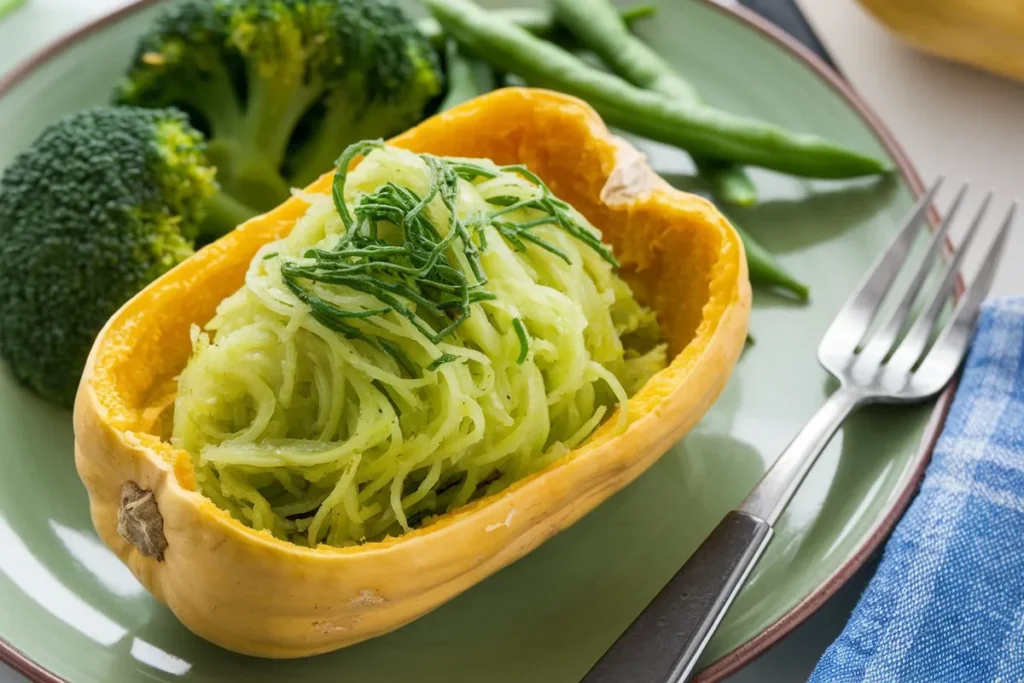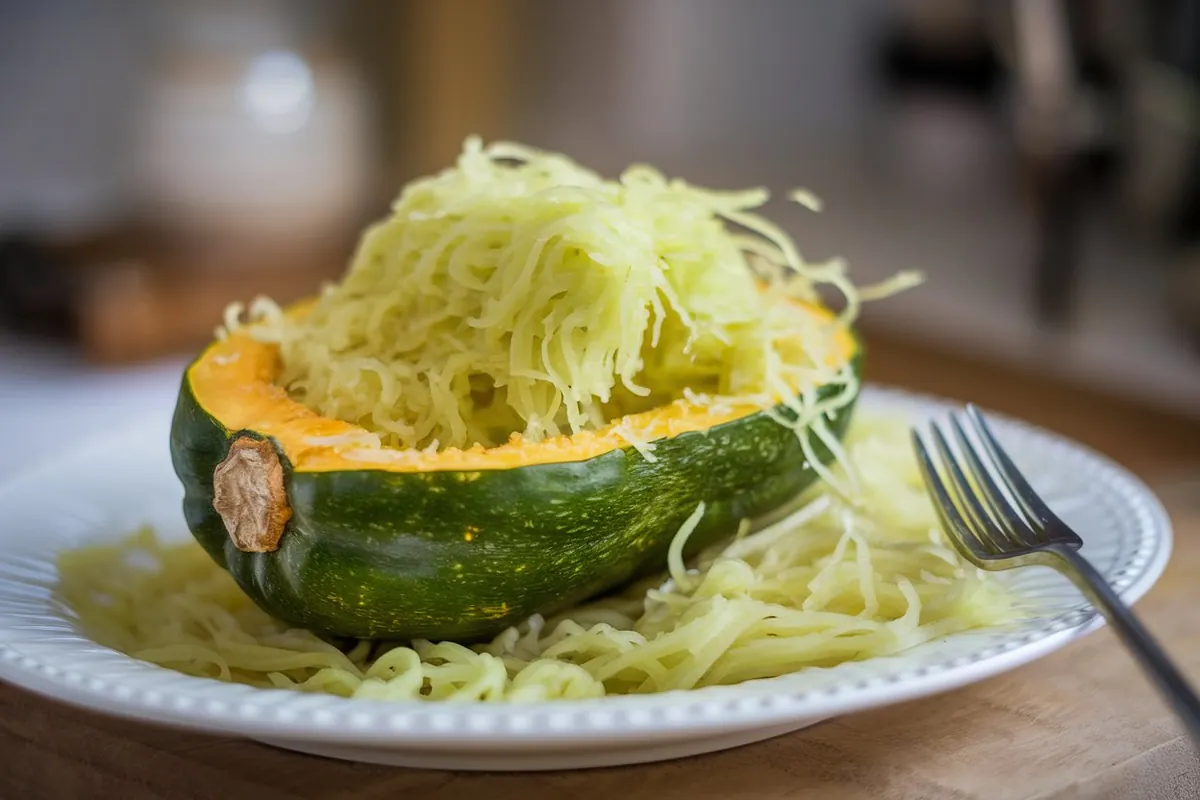Discovering a green spaghetti squash might leave you puzzled, especially if you’re accustomed to seeing the typical yellow or orange varieties. You might wonder: is it safe to eat? In this comprehensive guide, we’ll dive into everything you need to know about eating green spaghetti squash, from safety and taste differences to cooking tips and nutritional benefits. Along the way, we’ll address frequently asked questions and offer insights into the best ways to enjoy this unique vegetable.
What is Spaghetti Squash?
Spaghetti squash is a type of winter squash known for its remarkable ability to transform into spaghetti-like strands when cooked. It’s a favorite among those following low-carb diets or looking for healthier alternatives to pasta. The squash is low in calories, but rich in essential nutrients such as vitamins A, C, and B6, as well as potassium, folate, and fiber. These nutrients support various aspects of health, including immune function, skin health, digestion, and heart health.
The squash is usually harvested when its outer skin turns yellow or orange, indicating ripeness. However, you may come across a spaghetti squash that’s still green. So, what does it mean when the squash is green, and is it okay to eat?
Why is My Spaghetti Squash Green?
There are several reasons why you might find your spaghetti squash still green:
- Immature squash: The most common reason is that the squash hasn’t fully ripened. Spaghetti squash typically starts off green and transitions to a yellow or orange hue as it matures.
- Environmental factors: Insufficient sunlight, improper watering, or other adverse weather conditions can delay the ripening process, causing the squash to stay green even when it’s fully grown.
- Hybrid varieties: Certain varieties of spaghetti squash may naturally have a green tint, even when mature. These hybrid varieties are less common but are still safe to eat.
Understanding the factors that affect squash ripeness can help you decide whether to wait for your squash to ripen or cook it while green.
For a detailed explanation on how to check for squash ripeness and when it’s best to harvest, you can read this guide on recognizing ripe squash.
Is It Safe to Eat Green Spaghetti Squash?
Yes, green spaghetti squash is generally safe to eat, although there are a few considerations to keep in mind.
- Safety of consumption: As long as the squash isn’t spoiled (showing signs of mold, soft spots, or a foul smell), it’s perfectly fine to eat. The green color often indicates immaturity rather than spoilage.
- Health benefits: Green spaghetti squash retains most of its nutritional value, even if it hasn’t fully ripened. It still provides valuable vitamins and minerals like vitamins A and C, potassium, and fiber. However, it might have slightly lower concentrations of these nutrients compared to fully ripe squash.
For more information on the safety of unripe vegetables, including spaghetti squash, check out this helpful resource.
Taste Differences: Green vs. Ripe Spaghetti Squash
One of the most noticeable differences between green and ripe spaghetti squash is the taste. Ripe spaghetti squash is known for its mild, slightly sweet flavor and tender, spaghetti-like texture. In contrast, green spaghetti squash may taste somewhat different due to its immaturity.
- Green spaghetti squash: Typically firmer with a more neutral or slightly bitter taste. It doesn’t have the same level of sweetness as ripe squash, but it can still be used in savory dishes where a milder flavor is preferred.
- Ripe spaghetti squash: Softer texture with a stringier, spaghetti-like consistency. Its flavor is mild and slightly sweet, making it ideal for use as a pasta substitute or side dish.
If you’re open to trying different textures and flavors, cooking green spaghetti squash can add variety to your meals.
Cooking Green Spaghetti Squash: Techniques and Tips

Green spaghetti squash, while firmer and less sweet than its ripe counterpart, can still be prepared in several delicious ways. Here are a few popular methods for cooking green spaghetti squash:
1. Roasting
Roasting is one of the most common methods for cooking both ripe and unripe spaghetti squash. Here’s how to do it:
- Preheat your oven to 400°F (200°C).
- Slice the squash in half lengthwise and scoop out the seeds.
- Drizzle the inside with olive oil, sprinkle with salt and pepper, and place the halves cut-side down on a baking sheet.
- Roast for about 40-50 minutes, or until the squash is tender when pierced with a fork.
Roasting enhances the natural flavors of the squash and softens its texture, making it easier to enjoy even when it’s green.
2. Steaming or Boiling
If you want to soften the firmer texture of green spaghetti squash more quickly, steaming or boiling is an effective method.
- Cut the squash into smaller chunks or slices.
- Place in a steamer basket over boiling water or directly in a pot of boiling water.
- Cook for about 15-20 minutes, or until the squash is tender.
Steaming or boiling is ideal for recipes where you plan to mix the squash with other ingredients, such as casseroles or stir-fries.
3. Stir-frying
Green spaghetti squash’s firmer texture makes it suitable for stir-frying. This method allows you to quickly cook the squash while retaining some of its crispness.
- Cut the squash into small pieces or thin strips.
- Heat a tablespoon of oil in a large pan or wok.
- Add the squash and stir-fry over medium-high heat for 5-7 minutes until it’s cooked through but still slightly firm.
- Season with soy sauce, garlic, or your preferred stir-fry sauce for added flavor.
This technique is great for those who prefer their vegetables with a bit of a crunch, and it’s a quick option for weeknight meals.
For more creative recipe ideas on how to cook green spaghetti squash, try this green spaghetti recipe, which offers a delicious twist on traditional spaghetti squash dishes.
How to Use Green Spaghetti Squash in Recipes
Green spaghetti squash may have a different texture and flavor than ripe squash, but it’s still versatile in the kitchen. Here are several ways you can use it:
- Stir-fries: The firmer texture of green squash makes it perfect for stir-fries, where you want a bit of bite in your vegetables. Pair it with garlic, ginger, and soy sauce for an Asian-inspired dish.
- Casseroles: Add roasted or steamed green spaghetti squash to a casserole with vegetables, cheese, and a protein like chicken or tofu. The squash will absorb the flavors of the other ingredients.
- Pasta substitute: Even though green spaghetti squash isn’t as sweet, you can still use it as a pasta substitute. Serve it with your favorite sauce—whether it’s marinara, pesto, or Alfredo—and enjoy a low-carb, nutrient-packed meal.
- Salads: Incorporate lightly cooked green spaghetti squash into salads for added texture and nutritional benefits. Mix with leafy greens, nuts, and a tangy vinaigrette for a refreshing and healthy dish.
For more inspiration on how to incorporate green spaghetti squash into your meals, check out this detailed guide to squash-based dishes.
Nutritional Value of Green Spaghetti Squash
One of the major benefits of spaghetti squash, regardless of whether it’s green or ripe, is its impressive nutritional profile. Green spaghetti squash still provides a range of essential vitamins and minerals, making it a healthy addition to your diet. Here’s what you can expect:
- Vitamins A and C: These vitamins support immune health, promote healthy skin, and reduce inflammation. Vitamin C, in particular, acts as an antioxidant, helping to protect the body from free radical damage. For more details, check this WebMD article on the health benefits of spaghetti squash.
- Potassium: A key mineral for maintaining healthy blood pressure levels and supporting proper muscle and nerve function.
- Fiber: Green spaghetti squash is a good source of dietary fiber, which aids in digestion, promotes a feeling of fullness, and supports overall gut health.
Though the concentrations of some nutrients may be slightly lower in unripe squash, green spaghetti squash remains a nutrient-dense option that contributes to a balanced diet.
How to Tell If Your Spaghetti Squash is Ripe

Knowing when your spaghetti squash is ripe can help ensure that you get the best flavor and texture. Here are some key signs to look for:
- Color: A ripe spaghetti squash will typically be yellow or orange. Green indicates that the squash is likely unripe.
- Skin texture: The skin of a ripe squash will be hard and firm. If the skin feels soft or has blemishes, the squash may be overripe or starting to spoil.
- Stem: A dry, brown stem is usually a sign that the squash has ripened fully and is ready to be harvested or eaten.
If you’re harvesting spaghetti squash from your garden, it’s important to wait until the squash has developed these signs of ripeness before picking it. For more tips on determining when to harvest your squash, check out this guide on proper harvesting techniques.
FAQs
Can You Eat Spaghetti Squash When It’s Green?
Yes, you can eat green spaghetti squash. While the flavor and texture may differ from ripe squash, it’s safe to eat as long as there are no signs of spoilage. Green squash tends to be firmer and may have a more neutral or slightly bitter taste, but it can still be used in a variety of dishes.
How Can You Tell If Spaghetti Squash Has Gone Bad?
If the squash has soft spots, mold, a bad odor, or mushy flesh inside, it’s likely spoiled and should be discarded. Fresh spaghetti squash will have firm flesh and a neutral smell.
Conclusion
In conclusion, is it OK to eat green spaghetti squash? Absolutely! While green spaghetti squash may not have the same sweet flavor or tender texture as fully ripe squash, it’s still safe to eat and packed with nutrients. Whether you’re roasting it, steaming it, or using it in stir-fries or casseroles, green spaghetti squash can add variety and versatility to your meals.
For more creative ways to use green vegetables in your recipes, visit Avery Recipes.
